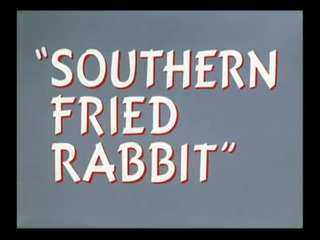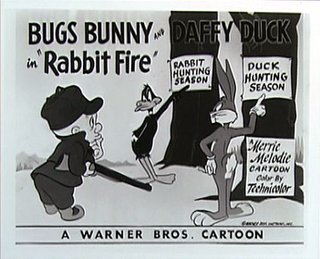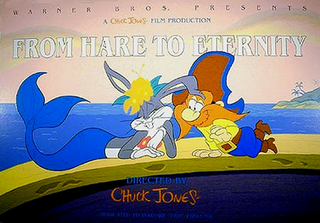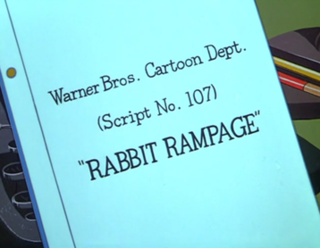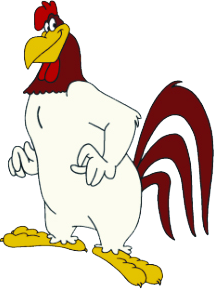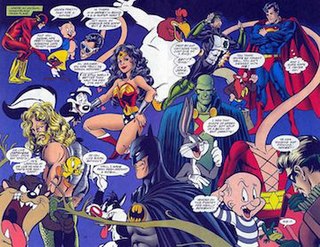Plot
The cartoon opens with titles featuring an instrumental of "The Sailor's Hornpipe" (also one of the theme songs to the Popeye cartoon series), seguéing to a scene of Sam as a pirate, who digs a hole to bury his treasure on a beach. Sam is singing the stereotypical pirate shanty Dead Man's Chest —on the second strain, Sam switches from the typical "yo-ho-ho and a bottle of rum!" to a decidedly more original "yo-ho-ho and a bottle of Ma's old fashioned ci-der", with a conga kick on the last syllable and a parody of "Dad's Old-Fashioned Root Beer" (a well-known radio advertising jingle at that time).
In attempting to bury his treasure, Sam has unknowingly encroached on Bugs Bunny's domain, as Bugs happens to have his rabbit hole there. When Bugs asks him who he is, he responds in his typical way: "What's up, doc?! I ain't no doc! I'm a pirate! Sea-Goin' Sam, the blood-thirstiest, shoot-'em-first-iest, doggone worst-iest buccaneer has ever sailed the Spanish main!"
To protect the location of his treasure, Sam prepares to shoot Bugs, claiming "Dead rabbits tell no tales!" Bugs then temporarily tricks Sam into trying to shoot himself in the head by saying: "Now, just a minute, Red. Ain't you got that wrong? You mean dead men tell no tales." After realizing he's been tricked, Sam grinds his teeth together so hard they shatter before firing at Bugs.
Bugs escapes in a tied lifeboat, at one point he rows himself towards Sam's ship without said lifeboat. As for Sam, seeing the paddles are gone, he swims towards the ship to retrieve the paddles from where Bugs left them—carrying them in his teeth and swimming in a dog-like style, and oblivious that he doesn't even need them since he already made it to the ship without them—, then returns to the lifeboat, which he then rows back to the ship.
As Sam searches for Bugs on the ship, he sees Bugs disguised as Captain Bligh, affecting the voice and thick-lipped appearance of Charles Laughton in his portrayal of Bligh in Mutiny On The Bounty . Sam takes criticism from "Captain Bligh", who then orders him to do a bunch of chores on deck, then turns to the audience and calls Sam a "maroon" (a play on the words "moron" and "marooned"). Sam soon realizes he's been tricked again, and follows a fleeing Bugs, but crashes into the mast while doing so.
In a side gag, Bugs tries to hide, but a pesky parrot keeps giving the rabbit away and crowing to Sam: "He's in there! He's in there! Awk!" Eventually, Bugs gets fed up with the parrot and asks him: "Polly want a cracker?" The parrot changes his tune: "Polly want a cracker! Polly want a cracker! Awk!" Bugs hands him a lit firecracker, which promptly explodes, blasting all of the bird's feathers off, leaving him dazed, smoldering and complaining before he passes out: "Me and my big mouth!" For the next part, Bugs poses as the now-unconscious parrot to lead Sam into a cannon. The rabbit then lights the fuse, the cannon explodes and Sam falls out of the barrel.
Bugs then gets into crow's nest, which works like an elevator, but when Sam tries to use it, the crow's nest squishes him. After popping back to normal, Sam orders Bugs to come down. Bugs mockingly tells him that the elevator is out of order and tosses him a rope. But when Sam climbs up the rope, the rope is now hanging on a pully, making Sam climb back down and slamming on the deck. For his next attempt, he tries to use a cannonball on a plank as a makeshift catapault, but it throws him right up into the bottom of the crow's nest. In another gag that skirts the laws of physics, Bugs tells Sam he's going to jump, though he instead drops a convenient anvil over the side of the crow's nest—Sam catches it, and the anvil's momentum causes the entire ship (except for the crow's nest) to submerge. Sam mouths some apparent curses underwater, then tosses the anvil overboard and the ship resurfaces.
When Bugs comes down to check on Sam, the latter proceeds to attack him with his sword, making Bugs mad that he's "sore again". Bugs crawls in a hatch in the ship's side, with Sam following with his sword: "Ooooh, I'll keelhaul you for this!". When he opens the board, he is blasted by a cannon. Bugs opens the hatch to Sam's left and calls: "Yoo-hoo! Mr. Pirate!". Sam opens that board and, again, gets blasted by a cannon. Bugs opens another hatch and calls: "Oh, uh, Redbeard!". Sam, trying to avoid getting blasted again, decides to open up the hatch with his sword from a safe distance. Suddenly, just as he opens that hatch, another hatch opens in his face and a cannon blasts him once more, much to his annoyance.
Sam now chases Bugs again, and is now subjected to the lots-of-doors in-and-out routine (previously used in Little Red Riding Rabbit ), which ends with Sam getting blasted yet again by a cannon. After that, Sam confronts Bugs, who throws a lighted match into the powder room, which a panicking Sam swiftly retrieves (a gag that would later be recycled into 1954's Captain Hareblower ). After this is repeated, Sam threatens to not go after the match if Bugs does it a third time. Bugs obliges, and Sam tries to distract himself with first a yo-yo, then with jacks (all while Bugs idly files his nails), until he finally gives in and goes to run after the burning match, but the powder room explodes before he can make a step, and pieces of the ship land on the beach, including the part of the ship with Bugs and Sam, with Bugs commenting that Sam "didn't make it." On his last nerve, Sam furiously chases Bugs with his gun ("Ooooh, I'll blast your head off for this!"), and Bugs flees back into his original rabbit hole. Sam gloats to Bugs and sticks his head into the rabbit hole ("Alright, now! I got ya cornered! Come out and meet your doom!"), a cannon blasts him once more from the rabbit hole.
Finally, Sam raises the white flag in defeat; whereas Bugs turns to the audience, puts on an old-style ship captain's hat, and paraphrases John Paul Jones by saying: "I have not even begun to fight!", before laughing.


